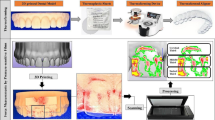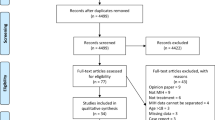Abstract
The aim of this study was to evaluate the effects of different techniques of surface treatment on the microleakage of a fissure sealant in molar teeth. A total of 50 freshly extracted noncarious human third molars were randomly assigned to one of five groups. Occlusal fissures were treated with one of the following: acid etching with 35% orthophosphoric acid (group 1); fissurotomy with a Fissurotomy Micro NTF metal bur (group 2); laser etching with an Er,Cr:YSGG laser at 2 W and 20 Hz (group 3); laser etching with an Er,Cr:YSGG laser at 2 W and 40 Hz (group 4); and air abrasion for 20 s with 30-µm Al2O3 particles via a CoJet Prep device (group 5). After surface pretreatment, a resin-based sealant was applied to the fissures. The sample teeth were subjected to thermocycling and stored in distilled water at 37°C for 1 month. Following immersion in 0.5% basic fuchsin solution for 24 h, three buccolingual slices of each sample tooth were scored under a stereomicroscope, and the morphological appearance of the area between the enamel surface and fissure sealant was examined under a scanning electron microscope. The Kruskal-Wallis test and one-way ANOVA revealed significant differences in marginal leakage, as follows: group 1 showed significantly lower scores than groups 2 and 5, the scores of groups 1, 3 and 4 were not significantly different, and group 2 showed significantly higher scores than groups 3 and 4. Laser irradiation, the metal bur, and the CoJet Prep device did not eliminate the need for acid etching of the enamel prior to placement of a fissure sealant. Laser etching at 2 W (20 Hz or 40 Hz) may be an alternative to conventional acid-etching.


Similar content being viewed by others
References
Waggoner WF, Siegal M (1996) Pit and fissure sealant application: updating the technique. J Am Dent Assoc 127:351–361
Pardi V, Sinhoreti MA, Pereira AC, Ambrosano GM, Meneghim Mde C (2006) In vitro evaluation of microleakage of different materials used as pit-and-fissure sealants. Braz Dent J 17:49–52
Subramaniam P, Konde S, Mandanna DK (2008) Retention of a resin-based sealant and a glass ionomer used as a fissure sealant: a comparative clinical study. J Indian Soc Pedod Prev Dent 26:114–120
Ripa LW (1980) Occlusal sealants: rationale and review of clinical trials. Int Dent J 30:127–139
Lepri TP, Souza-Gabriel AE, Atoui JA, Palma-Dibb RG, Pécora JD, Milori Corona SA (2008) Shear bond strength of a sealant to contaminated-enamel surface: influence of erbium:yttrium-aluminum-garnet laser pretreatment. J Esthet Restor Dent 20:386–394
Sungurtekin E, Oztaş N (2010) The effect of erbium,chromium:yttrium-scandium-gallium-garnet laser etching on marginal integrity of a resin-based fissure sealant in primary teeth. Lasers Med Sci 25:841–847
Garcia-Godoy F, Gwinnett AJ (1987) Penetration of acid solution and gel in occlusal fissures. J Am Dent Assoc 114:809–810
Martínez-Insua A, Da Silva DL, Rivera FG, Santana-Penín UA (2000) Differences in bonding to acid-etched or Er:YAG-laser-treated enamel and dentin surfaces. J Prosthet Dent 84:280–288
Yazici AR, Kiremitçi A, Celik C, Ozgünaltay G, Dayangaç B (2006) A two-year clinical evaluation of pit and fissure sealants placed with and without air abrasion pretreatment in teenagers. J Am Dent Assoc 137:1401–1405
Kramer N, García-Godoy F, Lohbauer U, Schneider K, Assmann I, Frankenberger R (2008) Preparation for invasive pit and fissure sealing: air-abrasion or bur? Am J Dent 21:383–387
Lin S, Caputo AA, Eversole LR, Rizoiu I (1999) Topographical characteristics and shear bond strength of tooth surfaces cut with a laser-powered hydrokinetic system. J Prosthet Dent 82:451–455
Visuri SR, Gilbert JL, Wright DD, Wigdor HA, Walsh JT Jr (1996) Shear strength of composite bonded to Er:YAG laser-prepared dentin. J Dent Res 75:599–605
Usumez A, Aykent F (2003) Bond strengths of porcelain laminate veneers to tooth surfaces prepared with acid and Er,Cr:YSGG laser etching. J Prosthet Dent 90:24–30
Cehreli SB, Gungor HC, Karabulut E (2006) Er,Cr:YSGG laser pretreatment of primary teeth for bonded fissure sealant application: a quantitative microleakage study. J Adhes Dent 8:381–386
Lee BS, Lin PY, Chen MH, Hsieh TT, Lin CP, Lai JY et al (2007) Tensile bond strength of Er,Cr:YSGG laser-irradiated human dentin and analysis of dentin-resin interface. Dent Mater 23:570–578
Borsatto MC, Corona SA, Ramos RP, Liporaci JL, Pecora JD, Palma-Dibb RG (2004) Microleakage at sealant/enamel interface of primary teeth: effect of Er:YAG laser ablation of pits and fissures. J Dent Child (Chic) 71:143–147
Moshonov J, Stabholz A, Zyskind D, Sharlin E, Peretz B (2005) Acid-etched and erbium:yttrium aluminium garnet laser-treated enamel for fissure sealants: a comparison of microleakage. Int J Paediatr Dent 15:205–209
Pope BD Jr, Garcia-Godoy F, Summitt JB, Chan DD (1996) Effectiveness of occlusal fissure cleansing methods and sealant micromorphology. ASDC J Dent Child 63:175–180
Jensen OE, Handelman SL (1980) Effect of an autopolymerizing sealant on viability of microflora in occlusal dental caries. Scand J Dent Res 88:382–388
Ganesh M, Shobha T (2007) Comparative evaluation of the marginal sealing ability of Fuji VII and Concise as pit and fissure sealants. J Contemp Dent Pract 8:10–18
Lupi-Pegurier L, Bertrand MF, Genovese O, Rocca JP, Muller-Bolla M (2007) Microleakage of resin-based sealants after Er:YAG laser conditioning. Lasers Med Sci 22:183–188
Taylor MJ, Lynch E (1992) Microleakage. J Dent 20:3–10
Bertrand MF, Semez G, Leforestier E, Muller-Bolla M, Nammour S, Rocca JP (2006) Er:YAG laser cavity preparation and composite resin bonding with a single-component adhesive system: relationship between shear bond strength and microleakage. Lasers Surg Med 38:615–623
Usumez S, Orhan M, Usumez A (2002) Laser etching of enamel for direct bonding with an Er,Cr:YSGG hydrokinetic laser system. Am J Orthod Dentofacial Orthop 122:649–656
Aasen SM, Ario PD (1993) Bonding systems: a comparison of maleic and phosphoric acids. J Dent Res 72:137–142
Oho T, Morioka T (1990) A possible mechanism of acquired acid resistance of human dental enamel by laser irradiation. Caries Res T 24:86–92
Hossain M, Nakamura Y, Yamada Y, Kimura Y, Nakamura G, Matsumoto K (1999) Ablation depths and morphological changes in human enamel and dentin after Er:YAG laser irradiation with or without water mist. J Clin Laser Med Surg 17:105–109
Bevilacqua L, Cadenaro M, Sossi A, Biasotto M, Di Lenarda R (2007) Influence of air abrasion and etching on enamel and adaptation of a dental sealant. Eur J Paediatr Dent 8:25–30
Hatibovic-Kofman S, Koch G (1991) Fluoride release from glass ionomer cement in vivo and in vitro. Swed Dent J 15:253–258
Knobloch LA, Meyer T, Kerby RE, Johnston W (2005) Microleakage and bond strength of primary enamel comparing air abrasion and acid etch techniques. Pediatr Dent 27:463–469
Herle GP, Joseph T, Varma B, Jayanthi M (2004) Comparative evaluation of glass ionomer and resin based fissure sealant using noninvasive and invasive techniques – a SEM and microleakage study. J Indian Soc Pedod Prev Dent 22:56–62
Geiger SB, Gulayev S, Weiss EI (2000) Improving fissure sealant quality: mechanical preparation and filling level. J Dent 28:407–412
Corona SA, Borsatto M, Dibb RG, Ramos RP, Brugnera A, Pecora JD (2001) Microleakage of class V resin composite restorations after bur, air-abrasion or Er:YAG laser preparation. Oper Dent 26:491–497
Hossain M, Nakamura Y, Yamada Y, Murakami Y, Matsumoto K (2002) Microleakage of composite resin restoration in cavities preparerd by Er, Cr: YSGG laser irradiation and etched bur cavities in primary teeth. J Clin Pediat Dent 26:263–268
Tengrungsun T, Smithrithee S, Vongsavan N, Chuckpaiwong S, Vongsavan K (2003) Investigation of Er:YAG laser etching on enamel–sealant interface in vitro SEM study. Int Congr 1248:201–208
Levy G, Koubi GF, Miserendino LJ (1998) Cutting efficiency of a mid-infrared laser on human enamel. J Endod 24:97–101
Youssef MN, Youssef FA, Souza-Zaroni WC, Turbino ML, Vieira MM (2006) Effect of enamel preparation method on in vitro marginal microleakage of a flowable composite used as pit and fissure sealant. Int J Paediatr Dent 16:342–347
Theodoridou-Pahini S, Tolidis K, Papadogiannis Y (1996) Degree of microleakage of some pit and fissure sealants: an in vitro study. Int J Paediatr Dent 6:173–176
do Rego MA, de Araujo MA (1999) Microleakage evaluation of pit and fissure sealants done with different procedures, materials, and laser after invasive technique. J Clin Pediatr Dent 24:63–68
Coluzzi DJ (2004) Fundamentals of dental lasers: science and instruments. Dent Clin North Am 48:751–770
Freitas PM, Navarro RS, Barros JA, Paula D, Eduardo C (2007) The use of Er:YAG laser for cavity preparation: an SEM evaluation. Microsc Res Tech 70:803–808
Delme KI, Deman PJ, Nammour S, De Moor RJ (2006) Microleakage of class V glass ionomer restorations after conventional and Er:YAG laser preparation. Photomed Laser Surg 24:715–722
Dunn WJ, Davis JT, Bush AC (2005) Shear bond strength and SEM evaluation of composite bonded to Er:YAG laser-prepared dentin and enamel. Dent Mater 21:616–624
Perito MA, Jorge AC, de Freitas PM, Cassoni A, Rodrigues JA (2009) Cavity preparation and influence of restorative materials on the prevention of secondary caries. Photomed Laser Surg 27:729–734
Author information
Authors and Affiliations
Corresponding author
Rights and permissions
About this article
Cite this article
Baygin, O., Korkmaz, F.M., Tüzüner, T. et al. The effect of different enamel surface treatments on the microleakage of fissure sealants. Lasers Med Sci 27, 153–160 (2012). https://doi.org/10.1007/s10103-011-0918-x
Received:
Accepted:
Published:
Issue Date:
DOI: https://doi.org/10.1007/s10103-011-0918-x




